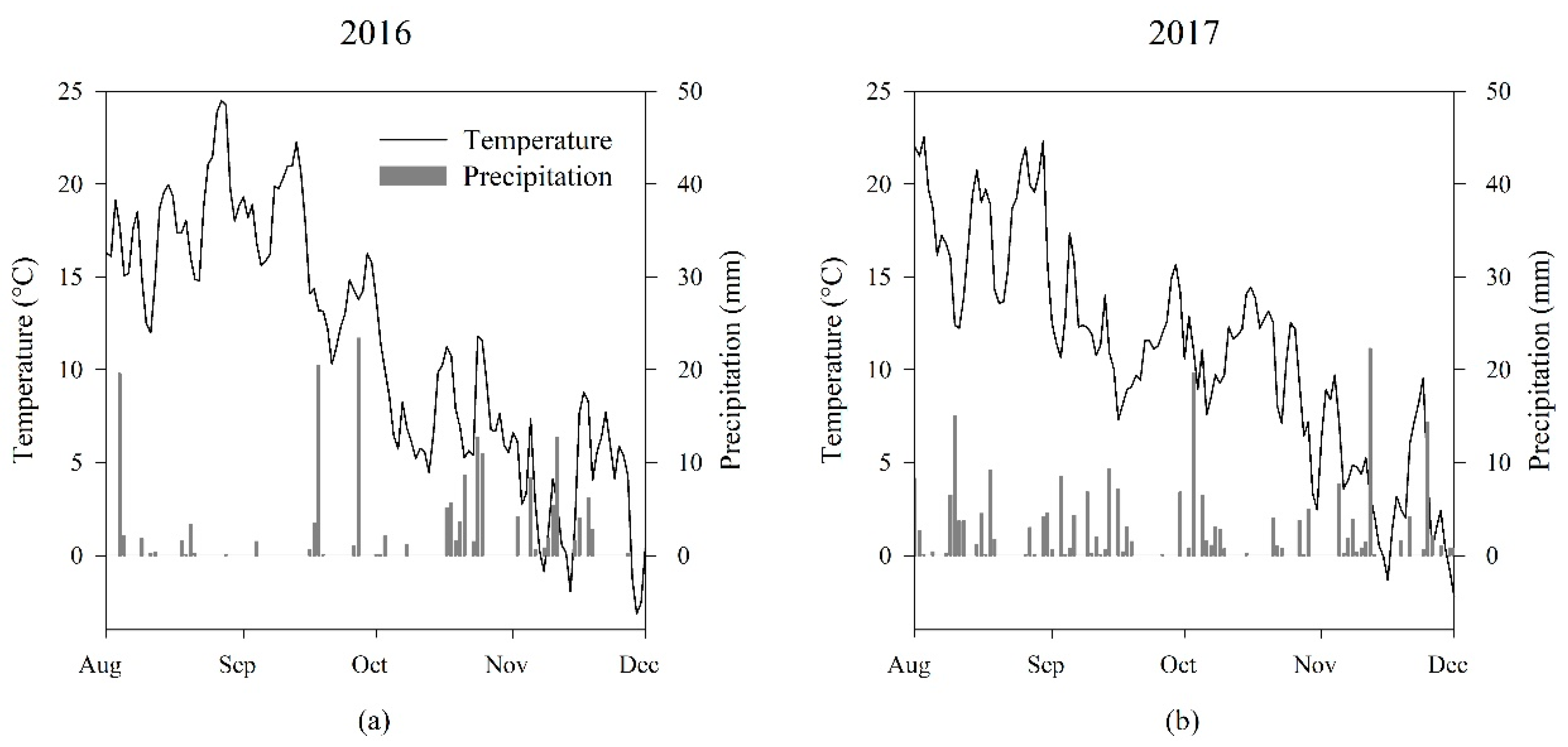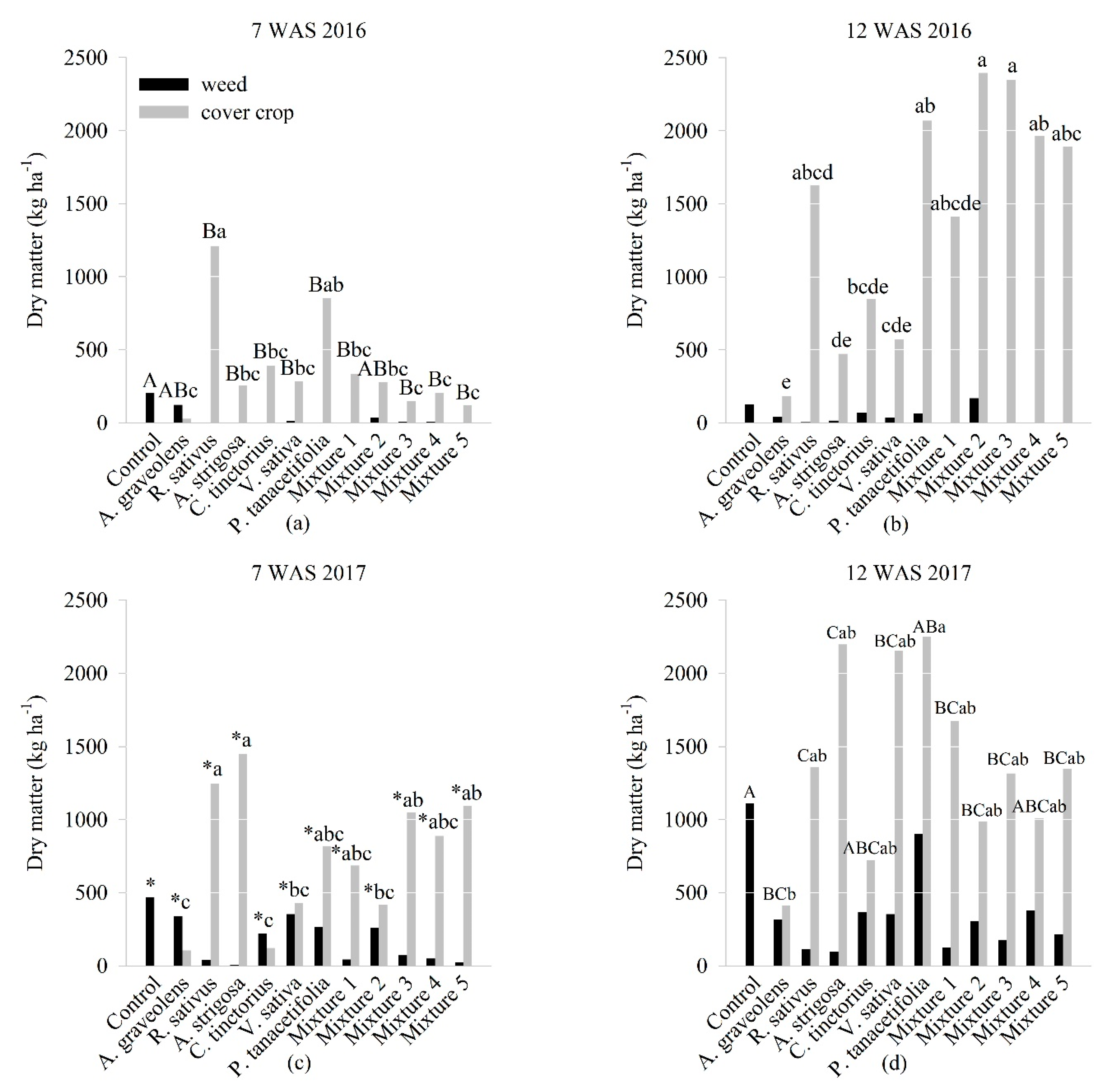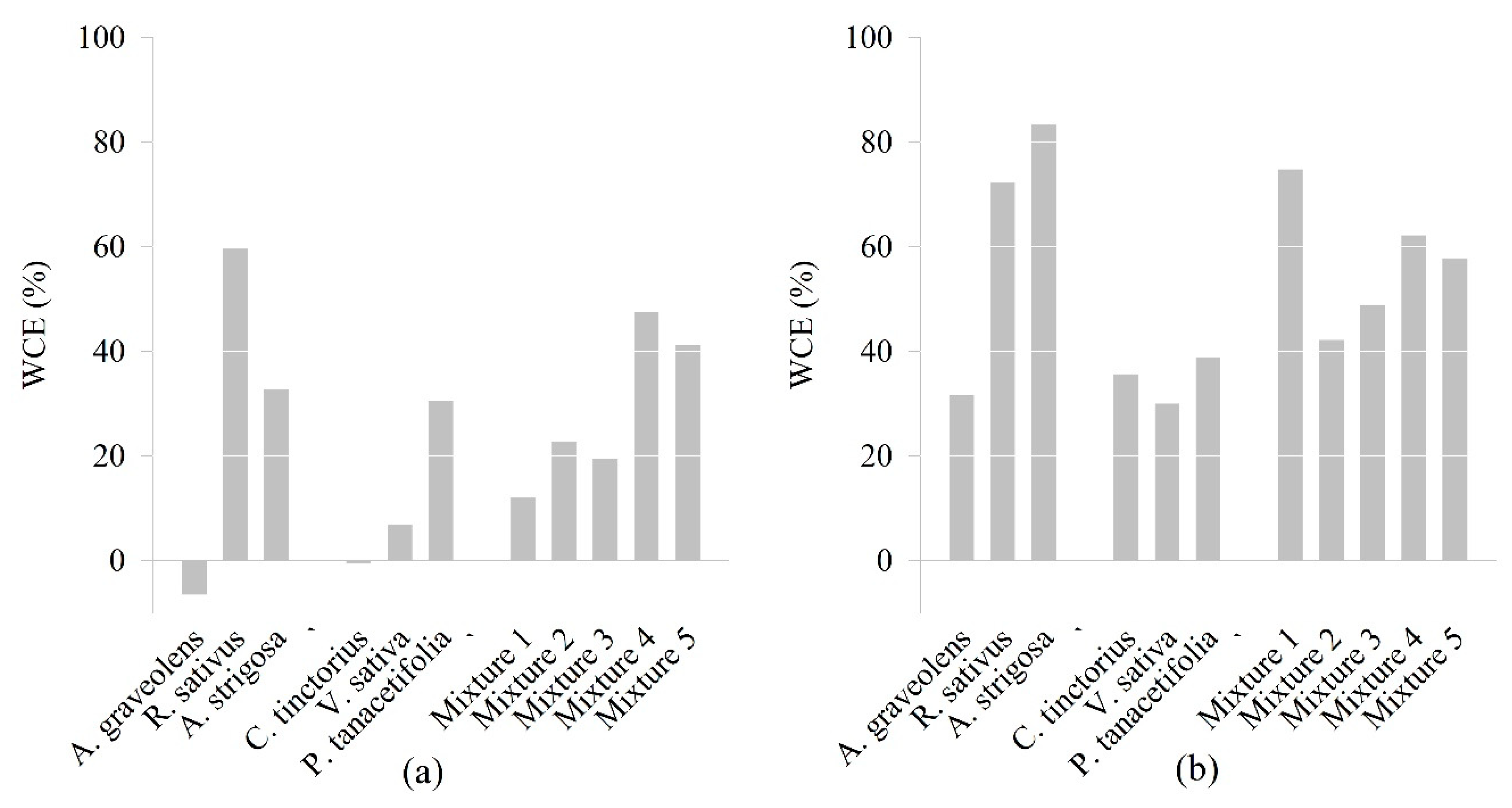Weed Control Ability of Single Sown Cover Crops Compared to Species Mixtures
Abstract
:1. Introduction
2. Materials and Methods
2.1. Experimental Sites
2.2. Data Collection
2.3. Data Analysis
3. Results
3.1. Cover Crop and Weed Development
3.2. Weed Control Efficacy
4. Discussion
5. Conclusions
Author Contributions
Funding
Acknowledgments
Conflicts of Interest
References
- European Parliament of the Council. Regulation (EU) No 1307/2013 of the European Parliament of the Council of 17 December 2013; Establishing Rules for Direct Payments to Farmers under Support Schemes within the Framework of the Common Agricultural Policy and Repealing Council Regulation (EC) No 637/2008 and Council Regulation (EC) No 73/2009.63; European Parliament of the Council: Brussels, Belgium, 2013. [Google Scholar]
- Hartwig, N.L.; Ammon, H.U. Cover crops and living mulches. Weed Sci. 2002, 50, 688–699. [Google Scholar] [CrossRef]
- Ellis, K.E.; Barbercheck, M.E. Management of overwintering cover crops influences floral resources and visitation by native bees. Environ. Entomol. 2015, 44, 999–1010. [Google Scholar] [CrossRef] [PubMed]
- Dunbar, M.W.; Gassmann, A.J.; O’Neal, M.E. Limited impact of a fall-seeded, spring-terminated rye cover crop on beneficial arthropods. Environ. Entomol. 2017, 46, 284–290. [Google Scholar] [CrossRef] [PubMed]
- Fourie, H.; Ahuja, P.; Lammers, J.; Daneel, M. Brassicacea-based management strategies as an alternative to combat nematode pests: A synopsis. Crop Prot. 2016, 80, 21–41. [Google Scholar] [CrossRef]
- Farooq, M.; Jabran, K.; Cheema, Z.A.; Wahid, A.; Siddique, K.H.M. The role of allelopathy in agricultural pest management. Pest Manag. Sci. 2011, 67, 493–506. [Google Scholar] [CrossRef] [PubMed]
- Gfeller, A.; Herrera, J.M.; Tschuy, F.; Wirth, J. Explanations for Amaranthus retroflexus growth suppression by cover crops. Crop Prot. 2018, 104, 11–20. [Google Scholar] [CrossRef]
- Blanco-Canqui, H.; Shaver, T.M.; Lindquist, J.L.; Shapiro, C.A.; Elmore, R.W.; Francis, C.A.; Hergert, G.W. Cover crops and ecosystem services: Insights from studies in temperate soils. Agron. J. 2015, 107, 2449–2474. [Google Scholar] [CrossRef]
- Brennan, E.B.; Smith, R.F. Winter cover crop growth and weed suppression on the central coast of California. Weed Technol. 2005, 19, 1017–1024. [Google Scholar] [CrossRef]
- Creamer, N.G.; Bennett, M.A.; Stinner, B.R.; Cardina, J.; Regnier, E.E. Mechanisms of weed suppression in cover crop-based production systems. HortScience 1996, 31, 410–413. [Google Scholar] [CrossRef]
- Putnam, A.R.; DeFrank, J.; Barnes, J.P. Exploitation of allelopathy for weed control in annual and perennial cropping systems. J. Chem. Ecol. 1983, 9, 1001–1010. [Google Scholar] [CrossRef]
- Tabaglio, V.; Marocco, A.; Schulz, M. Allelopathic cover crop of rye for integrated weed control in sustainable agroecosystems. Ital. J. Agron. 2013, 8, e5. [Google Scholar] [CrossRef]
- Teasdale, J.R.; Mohler, C.L. Light transmittance, soil temperature, and soil moisture under residue of hairy vetch and rye. Agron. J. 1993, 85, 673–680. [Google Scholar] [CrossRef]
- Teasdale, J.R.; Beste, C.E.; Potts, W.E. Response of weeds to tillage and cover crop residue. Weed Sci. 1991, 39, 195–199. [Google Scholar] [CrossRef]
- Wayman, S.; Cogger, C.; Benedict, C.; Collins, D.; Burke, I.; Bary, A. Cover crop effects on light, nitrogen, and weeds in organic reduced tillage. Agroecol. Sustain. Food Syst. 2015, 39, 647–665. [Google Scholar] [CrossRef]
- Falquet, B.; Gfeller, A.; Pourcelot, M.; Tschuy, F.; Wirth, J. Weed suppression by common buckwheat: A review. Environ. Control Biol. 2015, 53, 1–6. [Google Scholar] [CrossRef]
- Belz, R.G. Allelopathy in crop/weed interactions—an update. Pest Manag. Sci. 2007, 63, 308–326. [Google Scholar] [CrossRef] [PubMed]
- Hiltbrunner, J.; Liedgens, M.; Bloch, L.; Stamp, P.; Streit, B. Legume cover crops as living mulches for winter wheat: Components of biomass and the control of weeds. Eur. J. Agron. 2007, 26, 21–29. [Google Scholar] [CrossRef]
- Hajjar, R.; Jarvis, D.I.; Gemmill-Herren, B. The utility of crop genetic diversity in maintaining ecosystem services. Agric. Ecosyst. Environ. 2008, 123, 261–270. [Google Scholar] [CrossRef]
- Tilman, D.; Reich, P.B.; Knops, J.; Wedin, D.; Mielke, T.; Lehman, C. Diversity and productivity in a long-term grassland experiment. Science 2001, 294, 843–845. [Google Scholar] [CrossRef]
- Finckh, M.; Gacek, E.; Goyeau, H.; Lannou, C.; Merz, U.; Mundt, C.; Munk, L.; Nadziak, J.; Newton, A.; de Vallavieille-Pope, C.; et al. Cereal variety and species mixtures in practice, with emphasis on disease resistance. Agronomie 2000, 20, 813–837. [Google Scholar] [CrossRef] [Green Version]
- Huston, M.A. Hidden treatments in ecological experiments: Re-evaluating the ecosystem function of biodiversity. Oecologia 1997, 110, 449–460. [Google Scholar] [CrossRef] [PubMed]
- Tilman, D.; Lehman, C.L.; Thomson, K.T. Plant diversity and ecosystem productivity: Theoretical considerations. Proc. Natl. Acad. Sci. USA 1997, 94, 1857–1861. [Google Scholar] [CrossRef] [PubMed] [Green Version]
- Tribouillois, H.; Dürr, C.; Demilly, D.; Wagner, M.-H.; Justes, E. Determination of germination response to temperature and water potential for a wide range of cover crop species and related functional groups. PLoS ONE 2016, 11, e0161185. [Google Scholar] [CrossRef] [PubMed]
- Constantin, J.; Le Bas, C.; Justes, E. Large-scale assessment of optimal emergence and destruction dates for cover crops to reduce nitrate leaching in temperate conditions using the STICS soil-crop model. Eur. J. Agron. 2015, 69, 75–87. [Google Scholar] [CrossRef]
- Stott, P.A.; Stone, D.A.; Allen, M.R. Human contribution to the European heatwave of 2003. Nature 2004, 432, 610–614. [Google Scholar] [CrossRef] [PubMed]
- MacArthur, R.; Levins, R. The limiting similarity, convergence, and divergence of coexisting species. Am. Nat. 1967, 101, 377–385. [Google Scholar] [CrossRef]
- Abraham, C.T.; Singh, S.P. Weed management in sorghum-legume intercropping systems. J. Agric. Sci. 1984, 103, 103–115. [Google Scholar] [CrossRef]
- Tribouillois, H.; Fort, F.; Cruz, P.; Charles, R.; Flores, O.; Garnier, E.; Justes, E. A functional characterisation of a wide range of cover crop species: Growth and nitrogen acquisition rates, leaf traits and ecological strategies. PLoS ONE 2015, 10, e0122156. [Google Scholar] [CrossRef]
- Ofori, F.; Stern, W.R. Cereal–legume intercropping systems. Advances in Agronomy 1987, 41, 41–90. [Google Scholar]
- Brainard, D.C.; Bellinder, R.R.; Kumar, V. Grass-Legume mixtures and soil fertility affect cover crop performance and weed seed production. Weed Technol. 2011, 25, 473–479. [Google Scholar] [CrossRef]
- Baraibar, B.; Hunter, M.C.; Schipanski, M.E.; Hamilton, A.; Mortensen, D.A. Weed suppression in cover crop monocultures and mixtures. Weed Sci. 2018, 66, 121–133. [Google Scholar] [CrossRef]
- Inderjit; Asakawa, C. Nature of interference potential of hairy vetch (Vicia villosa Roth) to radish (Raphanus sativus L.): Does allelopathy play any role? Crop Prot. 2001, 20, 261–265. [Google Scholar] [CrossRef]
- Kunz, C.; Sturm, D.J.; Varnholt, D.; Walker, F.; Gerhards, R. Allelopathic effects and weed suppressive ability of cover crops. Plant Soil Environ. 2016, 62, 60–66. [Google Scholar] [Green Version]
- Tschuy, F.; Gfeller, A.; Azevedo, R.; Khamissé, C.; Henriet, L.; Wirth, J. Weed suppression by cover crops: Analyzing different factors. Agrar. Schweiz 2014, 5, 292–299. [Google Scholar]
- Sturm, D.J.; Peteinatos, G.; Gerhards, R. Contribution of allelopathic effects to the overall weed suppression by different cover crops. Weed Res. 2018, 58, 331–337. [Google Scholar] [CrossRef]
- Teasdale, J.R. Contribution of cover crops to weed management in sustainable agricultural systems. J. Prod. Agric. 1996, 9, 475–479. [Google Scholar] [CrossRef]
- Hooper, D.U.; Chapin, F.S.; Ewel, J.J.; Hector, A.; Inchausti, P.; Lavorel, S.; Lawton, J.H.; Lodge, D.M.; Loreau, M.; Naeem, S. Effects of biodiversity on ecosystem functioning: A consensus of current knowledge. Ecol. Monogr. 2005, 75, 3–35. [Google Scholar] [CrossRef]
- Tilman, D. The ecological consequences of changes in biodiversity: A search for general principles. Ecology 1999, 80, 1455–1474. [Google Scholar] [CrossRef]
- Hector, A.; Schmid, B.; Beierkuhnlein, C.; Caldeira, M.C.; Diemer, M.; Dimitrakopoulos, P.G.; Finn, J.A.; Freitas, H.; Giller, P.S.; Good, J. Plant diversity and productivity experiments in European grasslands. Science 1999, 286, 1123–1127. [Google Scholar] [CrossRef]
- Prieto, I.; Violle, C.; Barre, P.; Durand, J.-L.; Ghesquiere, M.; Litrico, I. Complementary effects of species and genetic diversity on productivity and stability of sown grasslands. Nat. Plants 2015, 1, 15033. [Google Scholar] [CrossRef]
- Blesh, J. Functional traits in cover crop mixtures: Biological nitrogen fixation and multifunctionality. J. Appl. Ecol. 2018, 55, 38–48. [Google Scholar] [CrossRef]
- Finney, D.M.; Kaye, J.P. Functional diversity in cover crop polycultures increases multifunctionality of an agricultural system. J. Appl. Ecol. 2017, 54, 509–517. [Google Scholar] [CrossRef]
- Wortman, S.E.; Francis, C.A.; Bernards, M.L.; Drijber, R.A.; Lindquist, J.L. Optimizing cover crop benefits with diverse mixtures and an alternative termination method. Agron. J. 2012, 104, 1425–1435. [Google Scholar] [CrossRef]
- Holmes, A.A.; Thompson, A.A.; Wortman, S.E. Species-specific contributions to productivity and weed suppression in cover crop mixtures. Agron. J. 2017, 109, 2808–2819. [Google Scholar] [CrossRef]
- Rasmussen, J. A model for prediction of yield response in weed harrowing. Weed Res. 1991, 31, 401–408. [Google Scholar] [CrossRef]
- Brust, J.; Gerhards, R. Lopsided oat (Avena strigosa) as a new summer annual cover crop for weed suppression in Central Europe. Jul. Kühn Arch. 2012, 257, 257–264. [Google Scholar]
- Finney, D.M.; White, C.M.; Kaye, J.P. Biomass production and carbon/nitrogen ratio influence ecosystem services from cover crop mixtures. Agron. J. 2016, 108, 39–52. [Google Scholar] [CrossRef]
- Rueda-Ayala, V.; Jaeck, O.; Gerhards, R. Investigation of biochemical and competitive effects of cover crops on crops and weeds. Crop Prot. 2015, 71, 79–87. [Google Scholar] [CrossRef]
- Brust, J.; Claupein, W.; Gerhards, R. Growth and weed suppression ability of common and new cover crops in Germany. Crop Prot. 2014, 63, 1–8. [Google Scholar] [CrossRef]
- Sturm, D.J.; Kunz, C.; Peteinatos, G.; Gerhards, R. Do cover crop sowing date and fertilization affect field weed suppression? Plant Soil Environ. 2017, 63, 82–88. [Google Scholar] [Green Version]
- Haramoto, E.R.; Gallandt, E.R. Brassica cover cropping: I. Effects on weed and crop establishment. Weed Sci. 2005, 53, 695–701. [Google Scholar] [CrossRef]
- Petersen, J.; Belz, R.; Walker, F.; Hurle, K. Weed suppression by release of isothiocyanates from turnip-rape mulch. Agron. J. 2001, 93, 37–43. [Google Scholar] [CrossRef]
- Dorn, B.; Jossi, W.; van der Heijden, M.G.A. Weed suppression by cover crops: Comparative on-farm experiments under integrated and organic conservation tillage. Weed Res. 2015, 55, 586–597. [Google Scholar] [CrossRef]
- Brust, J.; Weber, J.; Gerhards, R. Do cover crop mixtures have the same ability to suppress weeds as competitive monoculture cover crops? Jul. Kühn Arch. 2014, 2014, 422–430. [Google Scholar]
- Smith, R.G.; Atwood, L.W.; Warren, N.D. Increased productivity of a cover crop mixture is not associated with enhanced agroecosystem services. PLoS ONE 2014, 9, e97351. [Google Scholar] [CrossRef] [PubMed]
- Hayden, Z.D.; Brainard, D.C.; Henshaw, B.; Ngouajio, M. Winter annual weed suppression in rye–vetch cover crop mixtures. Weed Technol. 2012, 26, 818–825. [Google Scholar] [CrossRef]
- Weiner, J.; Andersen, S.B.; Wille, W.K.-M.; Griepentrog, H.W.; Olsen, J.M. Evolutionary agroecology: The potential for cooperative, high density, weed-suppressing cereals. Evol. Appl. 2010, 3, 473–479. [Google Scholar] [CrossRef] [PubMed]
- Kunz, C.; Sturm, D.J.; Sökefeld, M.; Gerhards, R. Weed suppression and early sugar beet development under different cover crop mulches. Plant Prot. Sci. 2017, 53, 187–193. [Google Scholar] [Green Version]
- Akemo, M.C.; Regnier, E.E.; Bennett, M.A. Weed suppression in spring-sown rye (Secale cereale)–pea (Pisum sativum) cover crop mixes. Weed Technol. 2000, 14, 545–549. [Google Scholar] [CrossRef]
- McLaren, C.; Swanwpoel, P.A.; Bennet, J.E. Cover crop biomass production is more important than diversity for weed suppression. Crop Sci. 2019, 59, 733–748. [Google Scholar] [CrossRef]




| 2016 | 2017 | |
|---|---|---|
| Crop rotation | Winter wheat—cover crop | Winter barley—cover crop |
| Cereal harvest date | 8 August 2016 | 5 August 2017 |
| Soil preparation (depth) | Stubble cultivator + deep tillage (15 cm) + power harrow (6–8 cm) | Stubble cultivator + deep tillage (15 cm) + power harrow (6–8 cm) |
| Sowing date | 19 August 2016 | 25 August 2017 |
| Sowing depth | 2 cm | 2 cm |
| Treatment | Crop Species | Seed Density (kg ha−1) |
|---|---|---|
| Control | Without cover crops | - |
| A. graveolens | Single sown Anethum graveolens L. | 25 |
| R. sativus | Single sown Raphanus sativus var. oleiformis Pers. | 25 |
| A. strigosa | Single sown Avena strigosa Schreb. | 120 |
| C. tinctorius | Single sown Carthamus tinctorius L. | 40 |
| V. sativa | Single sown Vicia sativa L. | 100 |
| P. tanacetifolia | Single sown Phacelia tanacetifolia Benth. | 10 |
| Mixture 1 | Mixture with 33% A. graveolens, 33% R. sativus, 33% A. strigosa | 57 |
| Mixture 2 | Mixture with 33% P. tanacetifolia, 33% C. tinctorius, 33% V. sativa | 50 |
| Mixture 3 | 50% Mixture 1, 50% Mixture 2 | 53 |
| Mixture 4 | 20% Mixture 1, 80% Mixture 2 | 51 |
| Mixture 5 | 80% Mixture 1, 20% Mixture 2 | 55 |
| Treatments | Total Weed Density (Plants m−2) | ||
|---|---|---|---|
| 2016 | 2017 | ||
| Control | 62.5 A | 678.8 A | |
| A. graveolens | 49.9 AB | 433.8 ABC | |
| R. sativus | 13.1 C | 196.6 BC | |
| A. strigosa | 29.4 BC | 112.5 C | |
| C. tinctorius | 41.9 ABC | 452.5 ABC | |
| V. sativa | 37.5 ABC | 483.8 AB | |
| P. tanacetifolia | 20.0 BC | 382.5 ABC | |
| Mixture 1 | 30.0 BC | 168.8 BC | |
| Mixture 2 | 25.6 BC | 370.0 ABC | |
| Mixture 3 | 28.8 BC | 326.3 ABC | |
| Mixture 4 | 14.4 C | 237.5 ABC | |
| Mixture 5 | 27.5 BC | 272.5 ABC | |
© 2019 by the authors. Licensee MDPI, Basel, Switzerland. This article is an open access article distributed under the terms and conditions of the Creative Commons Attribution (CC BY) license (http://creativecommons.org/licenses/by/4.0/).
Share and Cite
Schappert, A.; Schumacher, M.; Gerhards, R. Weed Control Ability of Single Sown Cover Crops Compared to Species Mixtures. Agronomy 2019, 9, 294. https://doi.org/10.3390/agronomy9060294
Schappert A, Schumacher M, Gerhards R. Weed Control Ability of Single Sown Cover Crops Compared to Species Mixtures. Agronomy. 2019; 9(6):294. https://doi.org/10.3390/agronomy9060294
Chicago/Turabian StyleSchappert, Alexandra, Matthias Schumacher, and Roland Gerhards. 2019. "Weed Control Ability of Single Sown Cover Crops Compared to Species Mixtures" Agronomy 9, no. 6: 294. https://doi.org/10.3390/agronomy9060294





